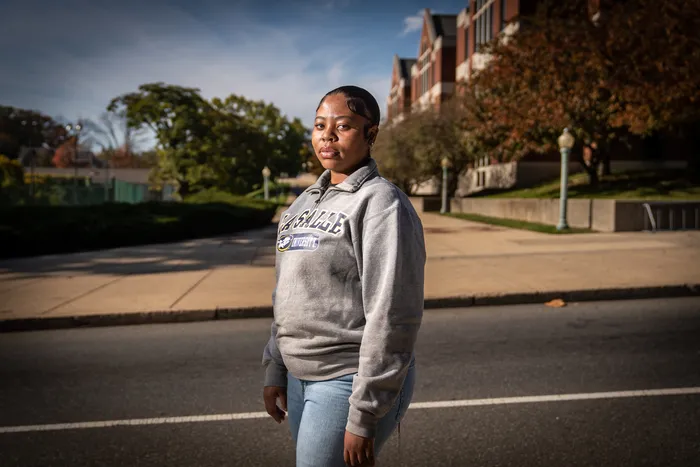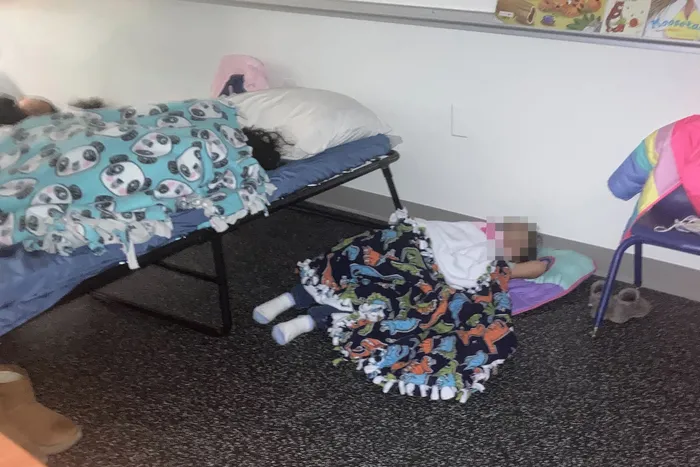Crushing Caseloads and Low Wages Drive Out Foster Care Workers, But Children Pay the Price
Advocates say chronic turnover must be addressed or the system will continue to fail children and families.

From The Philadelphia Inquirer
by Steve Volk and Julie Christie/Resolve Philly
Briana Royal became a case manager at Turning Points for Children two years ago with “a super hero complex,” she said. “You’re going to change the world.”
Royal, now 28, had hoped to offset the low $44,000 salary with the joy of helping children and families blossom.
Her job placed her near the front lines of the city foster care system. Turning Points is what’s known as a Community Umbrella Agency, a nonprofit company funded by the city Department of Human Services to care for kids removed from their families for alleged abuse or neglect.
Royal, who has a master’s degree in social work from Delaware State University, discovered the orderly process she’d learned in grad school and later training didn’t prepare her for the job.
High caseloads forced her to prioritize “putting out fires,” such as getting kids placed in new foster homes, while putting off important tasks like getting to know her client families. In response, Royal said she worked longer, completing the voluminous paperwork by laboring three days a week to 9 p.m. or even midnight.
Some colleagues, crushed by high caseloads, grew jaded: If a teen in their care ran away, she said, “they could check that box, ‘unable to find client,’ and say, ‘I can get them discharged from my case list.’”
Royal quickly amassed 13 cases, exceeding DHS’s funding ratio of 10 families per case manager. Then, in summer 2021, her manager raised all their caseloads “due to high rates of worker turnover.”
Two months later, she resigned. “I really cared about my clients,” says Royal, “but the money just didn’t match the work.”
Her story is typical of a child welfare industry in which advocates say high worker turnover, driven by long hours, low pay and thwarted ambitions to help families, has reached a crisis that can harm children.
/cloudfront-us-east-1.images.arcpublishing.com/pmn/6HRIQ36PKZALLOKWVLLVVWGPVM.jpg)
The trade organization for the industry, Pennsylvania Council of Children, Youth & Family Services (PCCYFS), was so concerned this summer about high caseloads that it warned Philadelphia DHS Commissioner Kimberly Ali that the problem would “create significant risk and potentially dangerous circumstances for the children and families we serve.”
That warning came weeks before the beating death, this July, of three-year-old Hope Jones. Her foster mother and case worker at the CUA have each been charged with third-degree murder and other crimes.
Child advocates caution that it’s far too soon to determine what lessons, if any, the child welfare system might take from the tragic death of a three-year-old in its care. Such tragedies typically garner news stories and public attention, but advocates insist long standing workforce problems must be addressed or the system will continue to fail children and families far too often.
Driving the crisis are three interrelated factors:
Caseloads: The Philadelphia budget allows CUAs to hire one social worker for every 10 assigned cases. But in eight of the city’s 10 CUAs, caseloads exceeded that, according to recent DHS data. Four had median caseloads of 15 or more.
Since a single case can involve siblings, the number of children assigned to one social worker is usually higher than a tally of cases. Internal data of 130 case workers, for June and July, obtained exclusively for this article, show that more than half of them were responsible for 18 or more foster kids each.
Staff pay: Starting case manager salaries at the CUAs average $46,000 a year, according to PCCYFS. Salaries across child welfare providers, contracted by the city, are about $2,000 to $15,000 lower than their civil service counterparts at Philadelphia DHS.
Turnover: This summer, the turnover rate at the CUAs averaged 45%, vastly higher than the already troubling 30% the industry has regularly reached in the past, according to the Pennsylvania Council. (The industry’s goal is 12%.)
“We have this system that is taking in all these kids,” said Mirela Huber, formerly in foster care and a trainer at Heero Consulting, which supports foster youth. “And we’re trusting this system to care for all these children when they can’t even keep a staff.”
‘Dang, you’re just moving on?’
Foster children, already under duress, bear the burden of chronic staff turnover, according to numerous interviews with young people who have left or aged out of the system.
/cloudfront-us-east-1.images.arcpublishing.com/pmn/324OCL25I5CDHKUZDK32J5TK2Y.jpg)
Kymirah Brown, 20, spent three years in foster care and averaged one case manager per year. They come and go on a regular basis, usually without saying goodbye, she said.
“It hurts,” she said. “Because you depend on them for pretty much everything, and if you don’t have a relationship with them, it just feels hopeless.”
High caseloads and turnover can cause delays that stretch on for weeks and months, said Brown, and affect clothing allowances, medical care, mental health needs, issues at school or problems, including abuse, in foster homes. “And when one of them leaves,” she said, “it’s like you’re starting all over again.”
What she wanted was a case manager who’d see “what I could be and help me get there,” she said. Short-term relationships didn’t create that bond.
» READ MORE: Missing kids, illicit activity: Staff warn of chaos at Philly DHS office that houses stranded kids
Keema Jones, 23, a former foster child and former member of Juvenile Law Center’s Advocates Transforming Youth Systems, said “a lot of us have had some kind of trauma. Repeating those things to new case managers is hard, and waiting for months to get connected with mental health services” is a challenge kids shouldn’t have to endure.
She, too, averaged one caseworker per year, feeling like she was “passed around” from one worker to the next.
“I lost one I really liked,” she said. “She actually told me she was going, and I was like ‘Dang, you’re just moving on and leaving me? I’ll never see you again?’”
/cloudfront-us-east-1.images.arcpublishing.com/pmn/LV3KW5ZQKFDYHG7CS3TG7KIZ7E.jpg)
‘Not pay you a cent extra’
When she worked at Northeast Treatment Centers, one of the city’s 10 CUAs, case manager Rashida Roach sometimes had to dip into her own pocket to buy groceries for a family in need, she said. Eventually, the long hours, stress and low pay “was just too much,” and she resigned.
Her experience echoes what case managers said in the PCCYFS survey.
“I feel like as a social worker we do so much and we are all under paid,” one worker wrote. “If I didn’t have a second income in my home I would need to have another job and sometimes the other income ain’t enough to cover bills. …We are out there from the crack of dawn and sometimes after work hours visiting families and neglecting our own.”
Agreeing on how many cases any manager should have is a subject of long contention in child welfare, but they clearly feel stressed and overworked.
“This is a model based on having 10-12 cases some people have double,” another worker wrote. “Let me ask, if you have a job description to start the job and I say imma double your workload and not pay you a cent extra for it how would any reasonable person feel.”
Child advocates like Cathleen Palm, founder of the Center for Children’s Justice, say workforce turnover has been a persistent problem that has gone unaddressed for years.
“Covid just made the current crisis worse than normal,” she says, as employees seek more flexibility to work from home and balance their personal lives.
CUA workers typically get new jobs paying $10,000 to $15,000 more at corporations like AmeriHealth Caritas, a health insurance provider, according to the trade group. The higher pay and more reasonable workloads elsewhere are too enticing for many workers to ignore.
The peril of canceled visits
The negative effects of worker turnover also extend into the homes of parents, who more typically have their kids removed because they don’t have the money to feed, clothe and house them, not for abuse.
/cloudfront-us-east-1.images.arcpublishing.com/pmn/SYKQVRHZNZENJGV7EWQP6KXOHA.jpg)
Kendra Outterbridge, a 34-year old mom who fought a DHS case to get her children back, says case managers sometimes cut corners in providing services to parents, even failing to provide court-mandated visits with their children, which can take time to schedule, oversee and provide transportation. “What happens,” said Outterbridge,”is that if the case manager cancels they still portray it in court as ‘mom didn’t make all her visits.’”
Outterbridge, now part of a network of Philly parents who support each other through DHS cases, said, “It happened to me, and I hear it from other parents all the time.”
For overworked case managers at the city CUAs, foregoing a parent-child visit might look like a way to lighten their load. For parents, however, a missed visit can pose a threat.
“The legal issue is that the lingo of child welfare is all about compliance,” Temple Law professor Sarah Katz, who directs and teaches the family law litigation clinic, said. “So when ‘missed visits’ are framed as the parent’s fault, she’s portrayed as ‘noncompliant,’ hurting her chances at reunification.”
Samea Kim, a vice president at PCCYFS, said she’s heard this complaint many times, but the problem often comes from the logistics in transporting the child. In court “it shouldn’t be reflected that the birth parent didn’t make their visit or that the CUA case manager was derelict…. It’s a much more complicated thing.”
Foster parents also feel the weight of overworked case managers.
» READ MORE: Philly took $5 million in foster children’s Social Security payments without telling them
Constance Iannetta, formerly in foster care and a foster parent herself, said, “Worker turnover affects everything.”
For example, education decisions require “team meetings,” meaning a case manager must be present. “So if you have a child who needs an individual education plan, and the caseworker just can’t make it, you have to just wait until everyone can get their schedules together again.”
DHS commissioner Ali acknowledged that turnover rates are a concern.
The department supported 3% pay increases for CUA staff this fiscal year and increased flexibility to make money available for hiring and retention, Ali said. Her agency also added a small pay raise for other foster care providers and has requested a budget increase from the state in fiscal 2024, to raise CUA case manager salaries to be competitive with the private corporations that have been poaching them. “The city and state have always been supportive in the annual budget process,” she said.
Ali, however, would not say whether she’d requested immediate funding from the Kenney administration to stop the outflow of workers.
/cloudfront-us-east-1.images.arcpublishing.com/pmn/IDLCYRDK4RE57GIWIHHYWXB5PY.jpg)
‘Sad and tragic case’
The killing of Hope Jones at first appeared tragically straight forward: The three year old’s foster mother, Kiana Casey, had allegedly beaten her to death, and was quickly charged with murder.
The case took an even darker twist this month, however, when Jones’s case manager, Jendayi Mawusi, was also charged with third-degree murder.
“This is a very sad and tragic case,” said Nadeem Bezar, a lawyer who has successfully sued the city’s CUAs on behalf of kids injured or killed in their care. He represents Jones’s estate.
Mawusi had 15 cases with 19 children, according to DHS.
» READ MORE: Caseworker charged in death of 3-year-old girl in foster care in Southwest Philadelphia
“Ten cases is a full-time job,” said Frank Cervone, executive director of the Support Center for Child Advocates, who cochaired a task force looking at the turnover crisis. “And when you start getting out to 13, 14, 15 cases, that’s more than a full-time job.”
A DHS spokesperson, in an email, declined to comment on Mawusi’s arrest or job performance.
It’s unclear at this stage what role Mawusi’s caseload might have played in her work on Jones’s case.
Scott Modell, a former deputy commissioner for children’s services in Tennessee and founder of Collaborative Safety, a consulting firm for human service agencies, said that agencies investigating such catastrophic failures should look at all the factors involved in the case worker’s decisions, not to absolve them but “to understand why they did it and try to make sure it doesn’t happen in the future.”
Caseloads, he says, would be one relevant factor to explore. “When a case manager can’t meet every requirement some of this becomes normal work — they’re checking the boxes, making decisions about parts of their job they will do and not do, based on the time pressure they face and whatever risk they perceive,” Modell said.
Improvements made but far to go
Family advocates suggest a straightforward if dramatic answer to the problem of worker turnover: Take fewer kids into care in the first place.
A common misunderstanding is that the leading reason kids are taken into the foster care system is because of physical or sexual abuse. But that accounts for only one of six cases. Children far more often are removed from their homes for “neglect,” which often amounts to symptoms of poverty, like food insecurity or unstable housing.
Supporting those families financially and with social services, rather than removing the child, would reduce caseloads significantly and allow workers to focus on the cases that really require intervention.
“Most of my cases, it was like a pattern of neglect,” said Roach, the former case worker, “and I would wonder, if the family needs food, why can’t we do more to help with that?” She wished she had had more services at her disposal to keep families together.
Philadelphia’s DHS has been working on this approach since 2018, and has lowered the rolls of youth in foster care by 35%. Even so, it has had higher removal rates of children in poverty than New York, Chicago and other large cities.
“Philadelphia has made improvements and they should be commended for that,” said Richard Wexler, executive director of the national committee for child protection reform, “but there is still a long way to go.”
Child advocates, including Casey Family Programs, the largest operating foundation focused on improving foster care and child welfare, have called to reduce the total number of kids in foster care by 50%.
» READ MORE: In Philly’s DHS crisis, a bleak reminder of how America treats its most vulnerable children | Editorial
The most dramatic example of reducing the foster rolls took place over the last decade in New Orleans, which cut the number of youth in foster care by about 75% from 2011 to 2019, with no increase in substantiated cases of repeat maltreatment or fatality rates.
There, juvenile judge Ernestine Gray, hearing removal cases, held that the child protection agency first had to show a safety risk to the child before a removal, not just lack of financial resources, the legal standard in Louisiana. “I did not think of what I was doing as revolutionary,” said Gray, since retired, in a recent interview, “but merely the application of the law.”
Pennsylvania has the same general legal standards for removing a child.
“There will be from time to time, the really egregious, egregious case where we don’t have any choice other than foster care,” said Gray, who works as a consultant.
“What has happened over the years is that we’ve seen it as a cure all. …I think foster care has to exist for that small number of really serious cases.”



